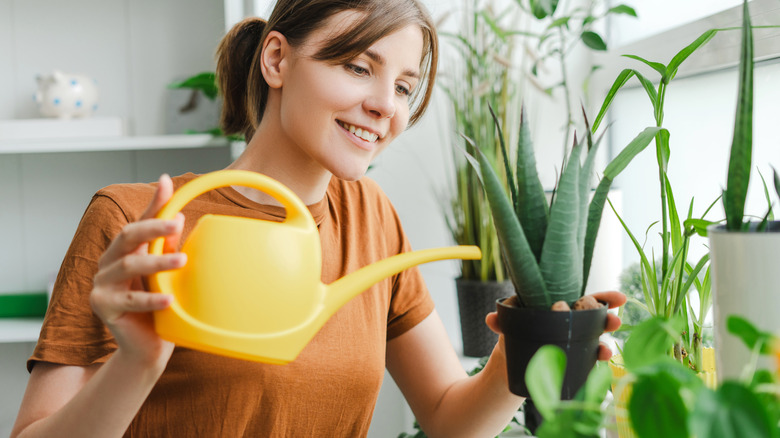Keep Your Aloe Vera Plants Happy And Healthy All Winter With These Simple Tips
We may receive a commission on purchases made from links.
The aloe vera (Aloe barbadensis miller) is a houseplant staple loved by both beginner gardeners and botany pros. Relatively easy to care for with intriguing fleshy, serrated leaves, this succulent can be found in homes and gardens across the country. However, despite being famously low-maintenance, there are things you need to do to take care of your aloe vera plant during winter to keep it happy and healthy. Hailing from Africa and the Arabian Peninsula, aloe vera plants are naturally found in warm, dry, bright environments. This means they can be sensitive to winter's cold snaps and dreary, wet weather.
To keep your aloe vera happy, you need to first consider its location. If they have been outside for the summer, you must bring them inside before temperatures dip below 50 degrees Farienheit. Once inside, place your aloe vera somewhere in direct sunlight. A windowsill may work, but you should still keep outside temperatures in mind. Windowsills can often experience cold drafts and air, and this may cause your plant to struggle. Sudden changes and fluctuations of temperatures can also be detrimental to your aloe, so think about a spot where the temperature will stay relatively constant. If your aloe vera has been indoors over the summer, ensure that the spot will stay warm and protected from cold drafts. Keeping large aloes on wheeled bases like these Idzo Acacia Wood Plant Caddies can make it easier to move them to a sheltered space.
Keep things bright, light, and not too damp
Hopefully, you are able to find a suitable location for your aloe vera over the winter months. However, there are other things to be mindful of when it comes to winter care. Aloes go dormant from October through to February, so you need to reduce watering during the off-season. In fact, you probably will only need to water your aloe vera plant once a month during winter, maybe even less. Keep an eye on your aloe during this time for signs of thirst and check the soil.
While you should water often enough to keep the soil from completely drying out, be wary of overwatering. Like most succulents, aloe needs excellent drainage and won't tolerate wet soil. Overwatering aloe plants or leaving them in soggy soil can cause them to rot or sag, especially while they're indoors for the winter.
You should also avoid feeding your aloe during its winter dormancy. Aloe vera plants tend not to need any fertilizing to stay happy and healthy, but any feed should be put off until the growing season, which is from March to September. As the winter months progress, keep checking on your plant and look out for common aloe plant issues that may arise over the winter, such as sagging or yellowing leaves. Overall, aloe plants should be relatively low-maintenance during the winter, as long as they have adequate light and well-draining soil.

